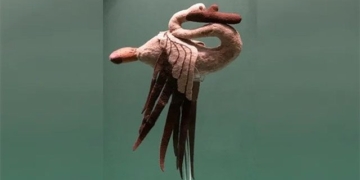Several large asteroids will pass by Earth from June 2 to June 4 without posing any threat.
According to NASA’s Jet Propulsion Laboratory (JPL), one of the four asteroids, named 2023 KS2, passed by Earth on June 2, while the other three asteroids—2023 HO18, 2023 JR2, and 2023 JE5—will fly by two days later, Newsweek reported.

Simulation of an asteroid flying near Earth. (Image: iStock).
Asteroids are rocky and icy bodies drifting around the solar system, mostly remnants from the planet formation process. “Asteroids are fragments of planets orbiting the Sun in the main belt located between Mars and Jupiter. However, due to their relatively small size, asteroids are easily influenced and can develop orbits that intersect with those of planets,” said the director of the Spaceguard Center in the UK.
The asteroid 2023 KS2 has a diameter of 20.7 meters, while the sizes of the asteroids 2023 HO18, 2023 JR2, and 2023 JE5 are 30.2, 36.6, and 33.5 meters, respectively. For comparison, a Boeing 737 is approximately 28.6 meters long. These asteroids will pass by Earth at distances of 3,942,892 km (2023 KS2), 6,517,843 km (2023 JR2), and 6,743,151 km (2023 JE5). Among them, 2023 HO18 is much closer at 466,709 km, which is about 1.2 times the distance between Earth and the Moon. For further comparison, Venus, the planet closest to Earth, is about 61.2 million km away at its nearest point.
Previously, NASA estimated that there are about 1.1 million asteroids in the solar system, the vast majority of which are located in the belt between Mars and Jupiter. The largest among them are the asteroids Ceres and Vesta, with diameters of 945 km and 529 km, respectively.
Occasionally, asteroids in the belt are pushed into the inner solar system by gravitational interactions with Jupiter, causing them to cross Earth’s orbit. They are classified as “Near-Earth Objects” (NEOs) if they are within 48.3 million km of Earth’s orbit. NASA has identified over 31,000 NEOs. Those that are more than 7.4 million km from Earth’s orbit and have diameters larger than 140 meters are referred to as “potentially hazardous objects.” Accordingly, there are 2,300 asteroids in this category. Based on this classification, all the asteroids passing by Earth this weekend are considered NEOs but are not classified as “hazardous” because they are not large enough.
Data from the Center for Near-Earth Object Studies (CNEOS) indicate that the four large, airplane-sized asteroids pose no risk of collision with Earth, with the collision risk for 2023 JE5 being only 0.000002. NASA’s Planetary Defense Coordination Office has not detected any hazardous objects that could collide with Earth in the next 100 years.


















































